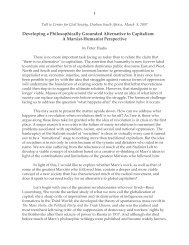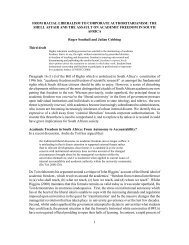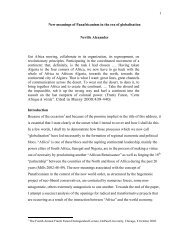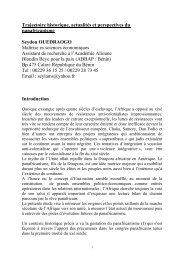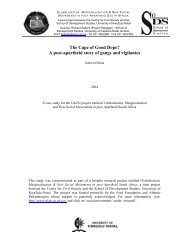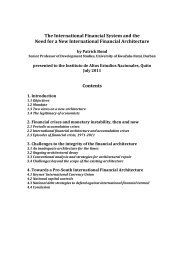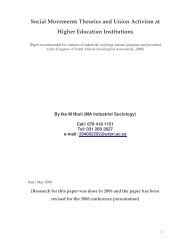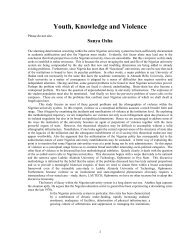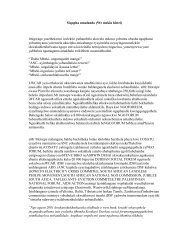April 2011 - Centre for Civil Society - University of KwaZulu-Natal
April 2011 - Centre for Civil Society - University of KwaZulu-Natal
April 2011 - Centre for Civil Society - University of KwaZulu-Natal
You also want an ePaper? Increase the reach of your titles
YUMPU automatically turns print PDFs into web optimized ePapers that Google loves.
also be required to provide reports on a regular basis. If the state is not<br />
satisfied with these reports or the progress <strong>of</strong> the company (as defined by the<br />
state itself) it can at any stage withdraw funding [15]. Thus, embarking on the<br />
path <strong>of</strong> registering Mine-Line as a co-operative has already meant that the<br />
workers’ control <strong>of</strong> the direction <strong>of</strong> the factory is, in reality, being<br />
undermined. Having the state nationalise a factory such as Mine-Line would<br />
only make this situation worse – it would hand the state even greater power<br />
over the workers. Considering that all states (even supposed workers’ states)<br />
and genuine workers’ control and democracy have proven to be irreconcilable,<br />
the consequences <strong>of</strong> such a move would, in all probability, be catastrophic.<br />
In fact, there are ample examples from history that demonstrate that the<br />
interests <strong>of</strong> workers’ self-management and state-ownership, including<br />
ownership under a so-called workers’ state, are incompatible. States have<br />
shown to have almost no interest in allowing workers to run their own affairs or<br />
to allow democracy in the workplace. The Soviet Union was a prime example <strong>of</strong><br />
this. It was the Soviet state, under the dictatorship <strong>of</strong> the Bolshevik Party,<br />
which crushed worker self-management. This happened shortly after the<br />
October revolution when the interests <strong>of</strong> the working class began to openly<br />
clash with those <strong>of</strong> the elite within the Bolshevik Party. As such, it was in 1918<br />
that Lenin ended worker self-management within Russia through decreeing the<br />
implementation <strong>of</strong> one-man management [16]. This saw the Soviet state<br />
appoint these new managers, <strong>of</strong>ten from the ranks <strong>of</strong> the old elite, and<br />
<strong>for</strong>cefully end any <strong>of</strong> democracy in the workplace – <strong>of</strong>ten at the point <strong>of</strong> a gun.<br />
The fact that the Soviet state had nationalised most <strong>of</strong> the factories, which had<br />
originally been seized by workers from the capitalist class, contributed to this –<br />
it gave the Soviet state immense power which it then wielded against the<br />
workers. In fact, the Soviet state accepted no independent initiative from<br />
workers in factories and state rule proved itself incompatible with workers<br />
self-management and direct democracy [17]. As workers were not, and could<br />
never be the state (due to its oppressive and hierarchical nature it was<br />
designed <strong>for</strong> a minority to rule over a majority), state ownership never<br />
translated into the socialisation <strong>of</strong> property and wealth, it never led to an end<br />
to capitalism, and it smothered workers’ control. As such, nationalisation also<br />
never broke the relations <strong>of</strong> production that defined capitalism; it rather reinstituted<br />
it and entrenched it. There<strong>for</strong>e, the very logic <strong>of</strong> all states has<br />
proven to be centralist, authoritarian and elitist. This means states are<br />
incompatible with genuine grassroots democracy, self-management and<br />
participation. If workers’ control was crushed by the state in a period <strong>of</strong><br />
revolution in Russia – using its ownership <strong>of</strong> enterprises as one weapon - why<br />
would it be any different in South Africa? As such, nationalisation under<br />
workers’ control has proved to be a historical oxymoron: a tactical and<br />
ideological dead end that undermines true workers’ control and selfmanagement.<br />
Rather raise the slogan <strong>of</strong> collectivization or socialisation<br />
A far better strategy, than calling <strong>for</strong> nationalisation under workers’ control,<br />
could be to try to use the example <strong>of</strong> the workers’ direct actions at Mine-Line<br />
to begin to rebuild a sense <strong>of</strong> class independence, class pride and worker selfmanagement<br />
more generally amongst the working class. Self-management and<br />
class pride are going to be vital in any broader struggle <strong>for</strong> genuine freedom.<br />
Mine-Line has the real potential to be a living example <strong>of</strong> class independence,<br />
class pride and self-management. In the hands <strong>of</strong> workers themselves it could<br />
become highly inspirational – as other occupations from places like Argentina<br />
have proven to be. It is these elements – <strong>of</strong> class pride, class independence and<br />
self-management - that need to be nurtured and fostered at Mine-Line. It is<br />
this that could be used to win concessions from the state, as would have to be<br />
done, from an independent class basis. Calling <strong>for</strong> nationalisation or even<br />
following a legal route does not do this. It rather fuzzes the fact that the state,<br />
along with the ex-owner, is an enemy <strong>of</strong> the workers. As such, the call <strong>for</strong>



